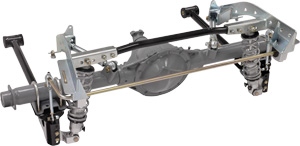Anti-Roll Bars
g-Bar and g-Link Rear Suspensions
|
|
Do I really need a rear anti-roll bar?In an effort to correct excessive body roll on early muscle cars, the common approach is to add a large front anti-roll bar. This may initially appear to correct the issue, but with the unintended result of increased understeer on an already nose-heavy vehicle. To regain vehicle cornering balance a rear anti-roll bar may be needed. For mild street-performance vehicles a rear anti-roll bar will provide a noticeable improvement to the “tightness” of the handling. However, on high-performance vehicles operating at or near the vehicle’s traction limits, careful testing is required. First, to determine need of a rear bar, and then to properly setup the vehicle to optimize cornering balance. Testing your vehicle with different springs, shock settings and anti-roll bars will definitely yield increased handling. If it is a specific look you are after then that’s a good enough reason to put one on your car. Nothing is better looking than our billet g-Bar, with splined-end anti-roll bar with billet aluminum arms. |
Billet Splined ARB - g-Bar |
Sliding Link ARB - g-Bar |
|





 Chassisworks developed different styles of rear anti-roll bars for use with our g-Bar/g-Link canted-rear-suspension systems.
The first, a solid, adjustable rate, bar mounted to the frame rearward of the rearend housing. The second, a splined-end,
tubular bar mounted to the rearend housing, below the axle. Special narrowed versions are also available for mini-tubbed g-Link suspension systems.
Chassisworks developed different styles of rear anti-roll bars for use with our g-Bar/g-Link canted-rear-suspension systems.
The first, a solid, adjustable rate, bar mounted to the frame rearward of the rearend housing. The second, a splined-end,
tubular bar mounted to the rearend housing, below the axle. Special narrowed versions are also available for mini-tubbed g-Link suspension systems.